Nanocrystalline Lanthanum Oxide Layers on Tubes Synthesized Using the Metalorganic Chemical Vapor Deposition Technique
Abstract
1. Introduction
2. Materials and Methods
3. Results and Discussion
4. Conclusions
Funding
Institutional Review Board Statement
Informed Consent Statement
Data Availability Statement
Conflicts of Interest
References
- Nieminen, M.; Putkonen, M.; Niinistö, L. Formation and stability of lanthanum oxide thin films deposited from β-diketonate precursor. Appl. Surf. Sci. 2001, 174, 155–165. [Google Scholar] [CrossRef]
- Vignolo, M.F.; Duhalde, S.; Bormioli, M.; Quintana, G.; Cervera, M.; Tocho, J. Structural and electrical properties of lanthanum oxide thin films deposited by laser ablation. Appl. Surf. Sci. 2002, 197–198, 522–526. [Google Scholar] [CrossRef]
- Kang, S.-W.; Rhee, S.-W. Deposition of La2O3 films by Direct Liquid Injection Metallorganic Chemical Vapor Deposition. J. Electrochem. Soc. 2002, 149, C345–C348. [Google Scholar] [CrossRef]
- Yang, C.; Fan, H.; Qiu, S.; Xi, Y.; Fu, Y. Microstructure and dielectric properties of La2O3 films prepared by ion beam assistant electron-beam evaporation. J. Non-Cryst. Solids 2009, 355, 33–37. [Google Scholar] [CrossRef]
- Zhang, X.; Tu, H.; Zhao, H.; Yang, M.; Wang, X.; Xiong, Y.; Yang, Z.; Du, J.; Wang, W.; Chen, D. Band structure and electronic characteristics of cubic La2O3 gate dielectrics epitaxially grown on InP substrates. Appl. Phys. Lett. 2011, 99, 132902. [Google Scholar] [CrossRef]
- Li, S.; Lin, Y.; Wu, Y.; Wu, Y.; Li, X.; Tian, W. Ni doping significantly improves dielectric properties of La2O3 films. J. Alloys Compd. 2020, 822, 153469. [Google Scholar] [CrossRef]
- Jun, J.-H.; Wang, C.-H.; Won, D.-J.; Choi, D.-J. Structural and electrical properties of a La2O3 thin film as a gate dielectric. J. Korean Phys. Soc. 2002, 41, 998–1002. [Google Scholar]
- Park, N.K.; Kang, D.K.; Kim, B.-H.; Jo, S.J.; Ha, J.S. Electrical properties of La2O3 thin films grown on TiN/Si substrates via atomic layer deposition. Appl. Surf. Sci. 2006, 252, 8506–8509. [Google Scholar] [CrossRef]
- Kim, H.J.; Jun, J.H.; Choi, D.J. Characteristics of La2O3 thin films deposited using metal organic chemical vapor deposition with different oxidant gas. Ceram. Int. 2008, 34, 953–956. [Google Scholar] [CrossRef]
- Scarel, G.; Debermardi, A.; Tsoutsou, D.; Spiga, S.; Capelli, S.C.; Lamagna, L.; Volkos, S.N.; Alia, M.; Fanciulli, M. Vibrational and electric properties of hexagonal La2O3 films. Appl. Phys. Lett. 2007, 91, 102901. [Google Scholar] [CrossRef]
- Li, X.L.; Tsoutsou, D.; Scarel, G.; Wiemer, C.; Capelli, S.C.; Volkos, S.N.; Lamagna, L.; Fanciulli, M. Chemical and structural properties of atomic layer deposited La2O3 films capped with a thin Al2O3 film. J. Vac. Sci. Technol. A 2009, 27, L1. [Google Scholar] [CrossRef]
- Wang, X.; Liu, H.; Zhao, L.; Fei, C.; Feng, X.; Chen, S.; Wang, Y. Structural properties characterized by the film thickness and annealing temperature for La2O3 films grown by atomic layer deposition. Nanoscale Res. Lett. 2017, 12, 233. [Google Scholar] [CrossRef]
- Armelao, L.; Pascolini, M.; Bottaro, G.; Bruno, G.; Giangregorio, M.M.; Losurdo, M.; Malandrino, G.; Lo Nigro, R.; Fragalà, M.E.; Tondello, E. Microstructural and optical properties modifications induced by plasma and annealing treatments of lanthanum oxide sol-gel thin films. J. Phys. Chem. C 2009, 113, 2911–2918. [Google Scholar] [CrossRef]
- Jbeli, R.; Boukhachem, A.; Ben Jamaa, L.; Mahdhi, N.; Saadallah, F.; Elhouichet, H.; Alleg, S.; Amlouk, M.; Ezzaouïa, H. An enhancement of photoluminescence property of Ag doped La2O3 thin films at room temperature. Spectrochim. Acta A 2017, 184, 71–81. [Google Scholar] [CrossRef] [PubMed]
- Brachetti-Sibaja, S.B.; Rodil, S.E.; Domínguez-Crespo, M.A.; Torres-Huerta, A.M.; Rodríguez, E.; López-Oyama, A.B. Optical properties of nanocrystalline La2O3 dielectric films deposited by radio frequency magnetron sputtering. Thin Solid Films 2017, 636, 615–621. [Google Scholar] [CrossRef]
- Jbeli, R.; Mami, A.; Bilel, C.; Saadallah, F.; Bouaicha, M.; Amlouk, M. Growth and investigation of LaNiO3/La2O3 composites films for optoelectronic application. Optik 2021, 247, 168013. [Google Scholar] [CrossRef]
- Yu, L.; Han, Y.; Lin, R.; Ge, K.; Zhang, C.; Zhang, J.; Jia, G. Controllable synthesis and luminescence properties of one-dimensional La2O3 and La2O3:Ln3+ (Ln = Er, Eu, Tb) nanorods with different aspect rations. J. Lumin. 2021, 229, 117663. [Google Scholar] [CrossRef]
- Lee, Y.; Lee, C.H.; Nam, T.; Lee, S.; Oh, I.-K.; Yang, J.Y.; Choi, D.W.; Yoo, C.; Kim, H.; Kim, W.-H.; et al. Hydrogen barrier performance of sputtered La2O3 films for InGaZnO thin-film transistor. J. Mater. Sci. 2019, 54, 11145–11156. [Google Scholar] [CrossRef]
- Ciontea, L.; Nasui, M.; Petrisor, T., Jr.; Mos, R.B.; Gabor, M.S.; Varga, R.A.; Petrisor, T. Synthesis, crystal structure and thermal decomposition of [La2(CH3CH2COO)6·(H2O)3]·3.5H2O precursor for high-κ La2O3 thin films deposition. Mater. Res. Bull. 2010, 45, 1203–1208. [Google Scholar] [CrossRef]
- Imanaka, N.; Masui, T.; Kato, Y. Preparation of the cubic-type La2O3 phase by thermal decomposition of LaI3. J. Solid State Chem. 2005, 178, 395–398. [Google Scholar] [CrossRef]
- Patil, S.R.; Barhate, V.N.; Patil, V.S.; Khushabu, S.A.; Mahajan, A.M. The effect of post-deposition annealing on the chemical, structural and electrical properties of Al/ZrO2/La2O3/ZrO2/Al high-k nanolaminated MIM capacitors. J. Mater. Sci. Mater. Electron. 2022, 33, 11227–11235. [Google Scholar] [CrossRef]
- Zhao, W.; Jiang, J.; Luo, Y.; Li, J.; Ding, Y. Atomic layer deposition of La2O3 film with precursor La(thd)3-DMEA. Coatings 2023, 13, 870. [Google Scholar] [CrossRef]
- Patil, S.R.; Borokar, V.Y.; Rasadujjaman, M.; Zhang, Y.; Ding, S.J.; Mahajan, A.M. Investigation of PEALD ZrO2/La2O3-based high-k nanolaminates sandwiched between Al and Ti electrodes for MIM capacitors. J. Mater. Sci. Mater. Electron. 2023, 34, 1284. [Google Scholar] [CrossRef]
- Shen, Z.; Zhao, Y.; Tian, Z.; Huang, W.; Wu, J.; Lin, H. Effect of doping La2O3 on the structure and properties of the titanium barium silicate glass. J. Non-Cryst. Solids 2018, 499, 17–24. [Google Scholar] [CrossRef]
- Huang, X.; Zhao, D.; Ma, L.; Deng, C.; Li, L.; Chen, K.; Yang, X. Effect of La2O3 on crystallization of glass-ceramics. J. Non-Cryst. Solids 2020, 536, 120007. [Google Scholar] [CrossRef]
- Andriamasinoro, D.; Kieffer, R.; Kiennemann, A.; Rehspringer, J.L.; Poix, P.; Vallet, A.; Lavalley, J.C. Preparation and characterization of lanthana catalysts: Study of their activity in CO/H2 reactions. J. Mater. Sci. 1989, 24, 1757–1766. [Google Scholar] [CrossRef]
- Stoychev, D.; Valov, I.; Stefanov, P.; Atanasova, G.; Stoycheva, M.; Marinova, T. Electrochemical growth of thin La2O3 films on oxide and metal surfaces. Mater. Sci. Eng. C 2003, 23, 123–128. [Google Scholar] [CrossRef]
- Al-Najar, A.M.A.; Al-Doghachi, F.A.J.; Al-Riyahee, A.A.A.; Taufiq-Yap, Y.H. Effect of La2O3 as a promoter on the Pt,Pd,Ni/MgO catalyst in dry reforming of methane reaction. Catalysts 2020, 10, 750. [Google Scholar] [CrossRef]
- Boukha, Z.; Bermejo-López, A.; Pereda-Ayo, B.; González-Marcos, J.A.; González-Velasco, J.R. Study on the promotional effect of lanthana addition on the performance of hydroxyapatite-supported Ni catalysts for the CO2 methanation reaction. Appl. Catal. B Environ. 2022, 314, 121500. [Google Scholar] [CrossRef]
- Andrievskaya, E.R.; Kornienko, O.A.; Sayir, A.; Vasylkiv, O.O.; Sakka, Y. Phase relation studies in the ZrO2–CeO2-La2O3 system at 1000 °C. J. Am. Ceram. Soc. 2011, 94, 1911–1919. [Google Scholar] [CrossRef]
- Korniienko, O.A.; Yushkevich, S.V.; Bykov, I.O.; Samelyuk, A.V.; Bataiev, Y.M.; Zamula, M.V. Phase equilibrium in binary La2O3-Dy2O3 and ternary CeO2- La2O3-Dy2O3 systems. J. Eur. Ceram. Soc. 2022, 42, 5820–5830. [Google Scholar] [CrossRef]
- Li, J.; Cheng, J.; Wei, B.; Chen, P. Preparation and performance of ultrafine grained WC-10Co alloys with added La2O3. Ceram. Int. 2019, 45, 3969–3976. [Google Scholar] [CrossRef]
- Xu, X.; Liu, Y.; Tabie, V.; Yang, S.; Cai, C.; Xiao, Y.; Chen, H.; Liu, Q.; Zhang, X.; Li, C.; et al. Effect of La2O3 on resistance to high-temperature oxidation and corrosion of aluminized and aluminium-chrome coating. Mater. Res. Express 2019, 6, 1265b7. [Google Scholar] [CrossRef]
- Wu, T.; Liu, G.; Li, Y.; Zhang, Y.; Zhang, M.; Wu, B. Effect of La2O3 on the corrosion resistance of alumina ceramic. J. Mater. Res. Technol. 2020, 9, 6287–6296. [Google Scholar] [CrossRef]
- Kunlin, W.; Qingbo, Z.; Xingguo, W.; Yunming, Z. Rare-earth La2O3 modification of laser-clad coatings. J. Mater. Sci. 1998, 33, 3573–3577. [Google Scholar] [CrossRef]
- Liu, X.-B.; Yu, R.-L. Effect of La2O3 on microstructure and wear properties of laser clad γ/Cr7C3/TiC composite coatings on TiAl intermetallic alloy. Mater. Chem. Phys. 2007, 101, 448–454. [Google Scholar] [CrossRef]
- Farahmand, P.; Liu, S.; Zhang, Z.; Kovacevic, R. Laser cladding assisted by induction heating of Ni-WC and La2O3. Ceram. Int. 2014, 40, 15421–15438. [Google Scholar] [CrossRef]
- Li, M.; Han, B.; Wang, Y.; Pu, K. Effect of La2O3 on the microstructure and properties of laser cladding Ni-based ceramic coating. Optik 2017, 130, 1032–1037. [Google Scholar] [CrossRef]
- Krishnan, V.P.R.; Subramanian, M. Electrodeposition of Ni-La2O3 composite on AA6061 alloy and its enhanced hardness, corrosion resistance and thermal stability. Surf. Coat. Technol. 2017, 324, 471–477. [Google Scholar] [CrossRef]
- Zhang, D.; Cui, X.; Jin, G.; Cai, Z.; Dong, M. Thermal stability of Ni-B/La2O3 coatings by electro-brush plating technique. Surf. Coat. Technol. 2018, 349, 1042–1047. [Google Scholar] [CrossRef]
- Li, M.; Zhang, Q.; Han, B.; Song, L.; Cui, G.; Yang, J.; Li, J. Microstructure and property of Ni/WC/La2O3 coatings by ultrasonic vibration-assisted laser cladding treatment. Opt. Lasers Eng. 2020, 125, 105848. [Google Scholar] [CrossRef]
- Weng, F.; Yu, H.; Chew, Y.; Bi, G.; Du, X.; Tian, H.; Chen, C. Microstructure and mechanical behaviour of the laser synthesized composites modified by mico/nano scale rare earth oxides. J. Alloys Compd. 2022, 895, 162641. [Google Scholar] [CrossRef]
- Cheng, X.; Che, Y.; Song, R.; Li, H.; Liu, B.; Zhou, H.; Yan, L. Study of mechanical character and corrosion properties of La2O3 nanoparticle reinforced Ni-W composite coatings. Coll. Surf. A Physicochem. Eng. Asp. 2022, 652, 129799. [Google Scholar] [CrossRef]
- Li, J.; Zou, M.; Chen, W.; Hu, X.; Zhou, J.; Jiang, X. Diffusion behavior and electrical performance of La2O3 doped Ni-Co films and their application as metallic interconnection of solid oxide fuel cells. Thin Solid Films 2023, 768, 139692. [Google Scholar] [CrossRef]
- Cao, X.Q.; Vassen, R.; Stoever, D. Ceramic materials for thermal barrier coatings. J. Eur. Ceram. Soc. 2004, 24, 1–10. [Google Scholar] [CrossRef]
- Matsumoto, M.; Yamaguchi, N.; Matsubara, H. Low thermal conductivity and high temperature stability of ZrO2-Y2O3-La2O3 coatings produced by electron beam PVD. Scr. Mater. 2004, 50, 867–871. [Google Scholar] [CrossRef]
- CaO, X.Q.; Vassen, R.; Tietz, F.; Stoever, D. New double-ceramic-layer thermal barrier coatings based on zirconia-rare earth composite oxides. J. Eur. Ceram. Soc. 2006, 26, 247–251. [Google Scholar] [CrossRef]
- Xu, Z.; He, L.; Zhong, X.; Mu, R.; He, S.; Cao, X. Thermal barrier coating of lanthanum-zirconium-cerium composite oxide made by electron beam-physical vapor deposition. J. Alloys Compd. 2009, 478, 168–172. [Google Scholar] [CrossRef]
- Rauf, A.; Yu, Q.; Jin, L.; Zhou, C. Microstructure and thermal properties of nanostructured lanthana-doped yttria-stabilized zirconia thermal barrier coatings by air plasma spraying. Scr. Mater. 2012, 66, 109–112. [Google Scholar] [CrossRef]
- Cheng, B.; Yang, G.-J.; Zhang, Q.; Jang, N.; Zhang, M.; Zhang, Y.; Li, C.-X.; Li, C.-J. Gradient thermal cyclic behaviour of La2Zr2O7/YSZ DLC-TBCs with equivalent thermal insulation performance. J. Eur. Ceram. Soc. 2018, 38, 1888–1896. [Google Scholar] [CrossRef]
- Shen, Z.; He, L.; Xu, Z.; Mu, R.; Huang, G. LZC/YSZ double layer coatings: EB-PVD, microstructure and thermal cycling life. Surf. Coat. Technol. 2019, 367, 86–90. [Google Scholar] [CrossRef]
- Dong, T.-S.; Wang, R.; Di, Y.-L.; Wang, H.-D.; Li, G.-L.; Fu, B.-G. Mechanism of high temperature oxidation resistance improvement of double-layer thermal barrier coatings (TBCs) by La. Ceram. Int. 2019, 45, 9126–9135. [Google Scholar] [CrossRef]
- Feng, Y.; Dong, T.-S.; Li, G.-L.; Wang, R.; Zhao, X.-W.; Liu, Q. High temperature oxidation resistance of TGO growth mechanism of laser remelted thermal barrier coatings. J. Alloys. Compd. 2020, 828, 154266. [Google Scholar] [CrossRef]
- Taleghani, P.R.; Valefi, Z.; Ehsani, N. Evaluation of oxidation and thermal insulation capability of nanostructured La2(Zr0.7Ce0.3)2O7/YSZ functionally graded coatings. Ceram. Int. 2021, 47, 8915–8929. [Google Scholar] [CrossRef]
- Gao, L.; Guo, H.; Gong, S.; Xu, H. Plasma-sprayed La2Ce2O7 thermal barrier coatings against calcium-magnesium-alumina-silicate penetration. J. Eur. Ceram. Soc. 2014, 34, 2553–2561. [Google Scholar] [CrossRef]
- Kang, Y.X.; Bai, Y.; Fan, W.; Yuan, T.; Gao, Y.; Bao, C.G.; Li, B.Q. Thermal cycling performance of La2Ce2O7/50 vol.% YSZ composite thermal barrier coating with CMAS corrosion. J. Eur. Ceram. Soc. 2018, 38, 2851–2862. [Google Scholar] [CrossRef]
- Shreeram, B.; Rajendran, I.E.; Kumar, R. Tailoring of functionally graded mullite: La2O3 coatings by transferred arc plasma for thermal barrier coatings. J. Inorg. Organomet. Polym. Mater. 2018, 28, 2484–2493. [Google Scholar] [CrossRef]
- Sha, X.; Lü, Z.; Huang, X.; Miao, J.; Ding, Z.; Xin, X.; Su, W. Study on La and Y co-doped ceria based electrolyte materials. J. Alloys Compd. 2007, 428, 59–64. [Google Scholar] [CrossRef]
- Zheng, Y.; Shi, Y.; Gu, H.; Gao, L.; Chen, H.; Guo, L. La and Ca co-doped ceria-based electrolyte materials for IT-SOFC. Mater. Res. Bull. 2009, 44, 1717–1721. [Google Scholar] [CrossRef]
- Kahlaoui, M.; Inoubli, A.; Chefi, S.; Kouki, A.; Madani, A.; Chefi, C. Electrochemical and structural study of Ce0.8Sm0.2-xLaxO1.9 electrolyte materials for SOFC. Ceram. Int. 2013, 39, 6175–6182. [Google Scholar] [CrossRef]
- Jaiswal, N.; Upadhyay, S.; Kumar, D.; Parkash, O. Ionic conductivity investigation in lanthanum (La) and strontium (Sr) co-doped ceria system. J. Power Sources 2013, 222, 230–236. [Google Scholar] [CrossRef]
- Venkataramana, K.; Madhuri, C.; Madhusudan, C.; Reddy, J.S.; Bhikshamaiah, G.; Reddy, C.V. Investigation of La3+ and Dy3+ co-doped ceria ceramics with an optimized average atomic number of dopants for electrolytes in IT-SOFC. Ceram. Int. 2018, 44, 6300–6310. [Google Scholar] [CrossRef]
- Liu, J.; Wu, K.; Tu, T.; Peng, K. Preparation and properties of lanthanum (La) and indium (In) co-doped ceria system for IT-SOFC. Ionics 2019, 25, 1747–1757. [Google Scholar] [CrossRef]
- Sammes, N.M.; Du, Y.; Bove, R. Design and fabrication of a 100 W anode supported micro-tubular SOFC stack. J. Power Sources 2005, 145, 428–434. [Google Scholar] [CrossRef]
- Li, G.; Gou, Y.; Qiao, Y.; Sun, W.; Wang, Z.; Sun, K. Recent progress of tubular solid oxide fuel cell: From materials to applications. J. Power Sources 2020, 477, 228693. [Google Scholar] [CrossRef]
- Sawka, A.; Kwatera, A. Deposition of Sm2O3-doped CeO2 layers using the MOCVD method. Ceram. Int. 2016, 42, 1446–1452. [Google Scholar] [CrossRef]
- Sawka, A.; Kwatera, A. Deposition of gadolinia-doped ceria layers by MOCVD at low temperatures. Ceram. Int. 2018, 44, 6257–6264. [Google Scholar] [CrossRef]
- Sawka, A.; Kwatera, A. Low temperature synthesis of Y2O3-doped CeO2 layers using MOCVD. Mater. Sci. Eng. B 2022, 276, 115580. [Google Scholar] [CrossRef]
- Kwatera, A. Thin CVD layers of carbon-doped silicon nitride on quartz glass. Ceram. Int. 1989, 15, 65–72. [Google Scholar] [CrossRef]
- Kwatera, A. Models of the processes at the substrate surface in the CVD method. Ceram. Int. 1991, 17, 11–23. [Google Scholar] [CrossRef]
- Sawka, A. MOCVD growth of gadolinium oxide layers on tubes. Ceram. Int. 2023, 49, 23835–23843. [Google Scholar] [CrossRef]
- Morosanu, C.-E. The preparation, characterization and applications of silicon nitride thin films. Thin Solid Films 1980, 65, 171–208. [Google Scholar] [CrossRef]
- Dryden, H.L. Review of published data on the effect of roughness on transition from laminar to turbulent flow. J. Aeronaut. Sci. 1953, 320, 477–482. [Google Scholar] [CrossRef]
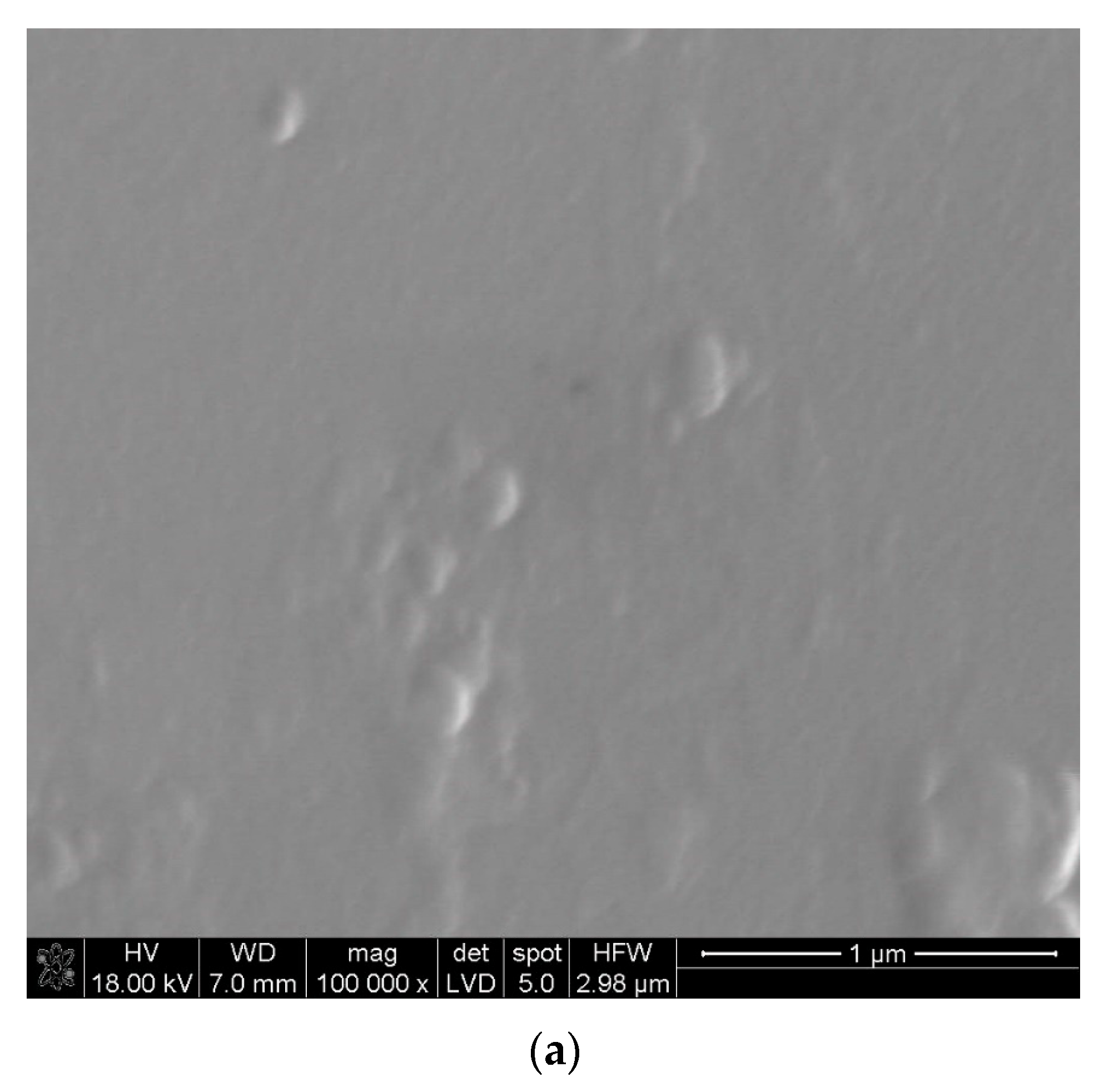

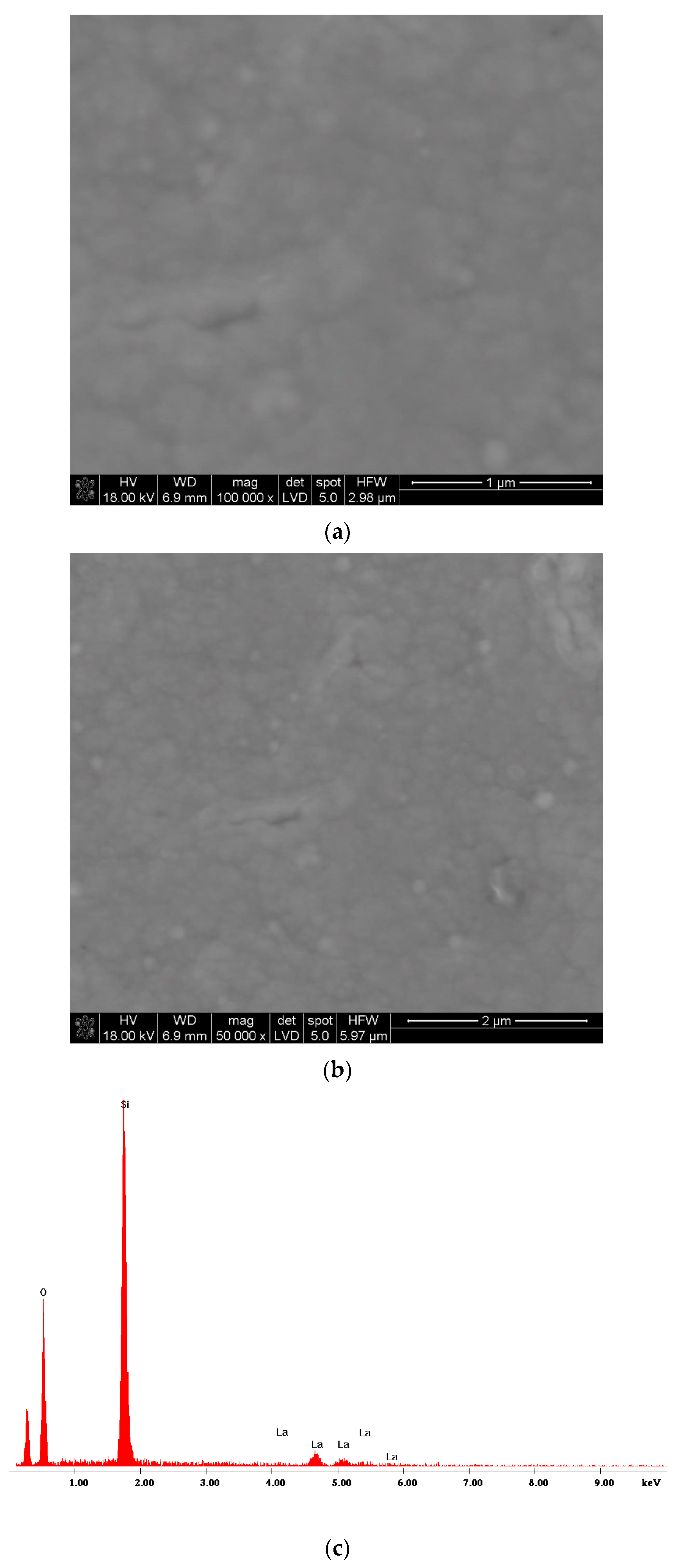
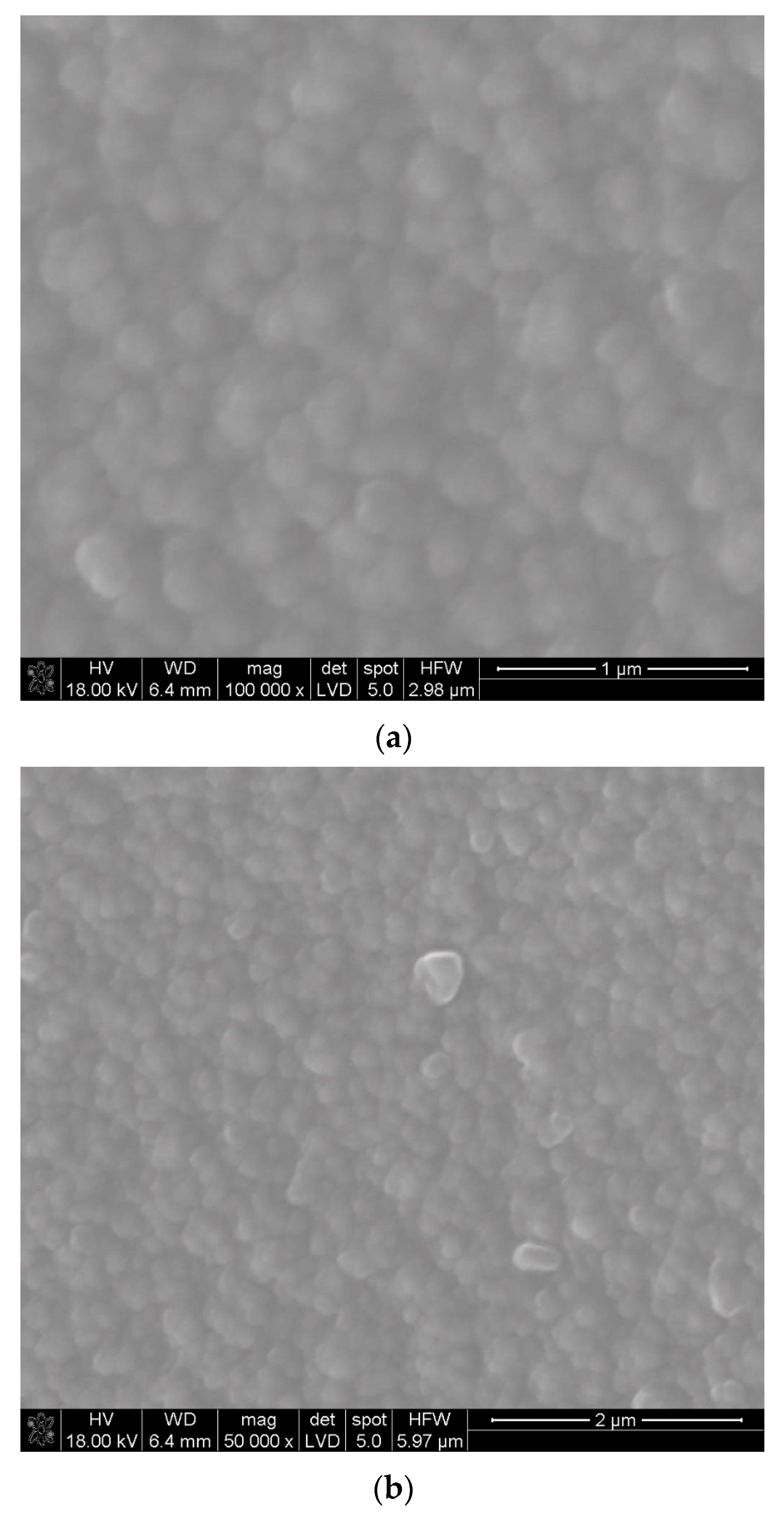

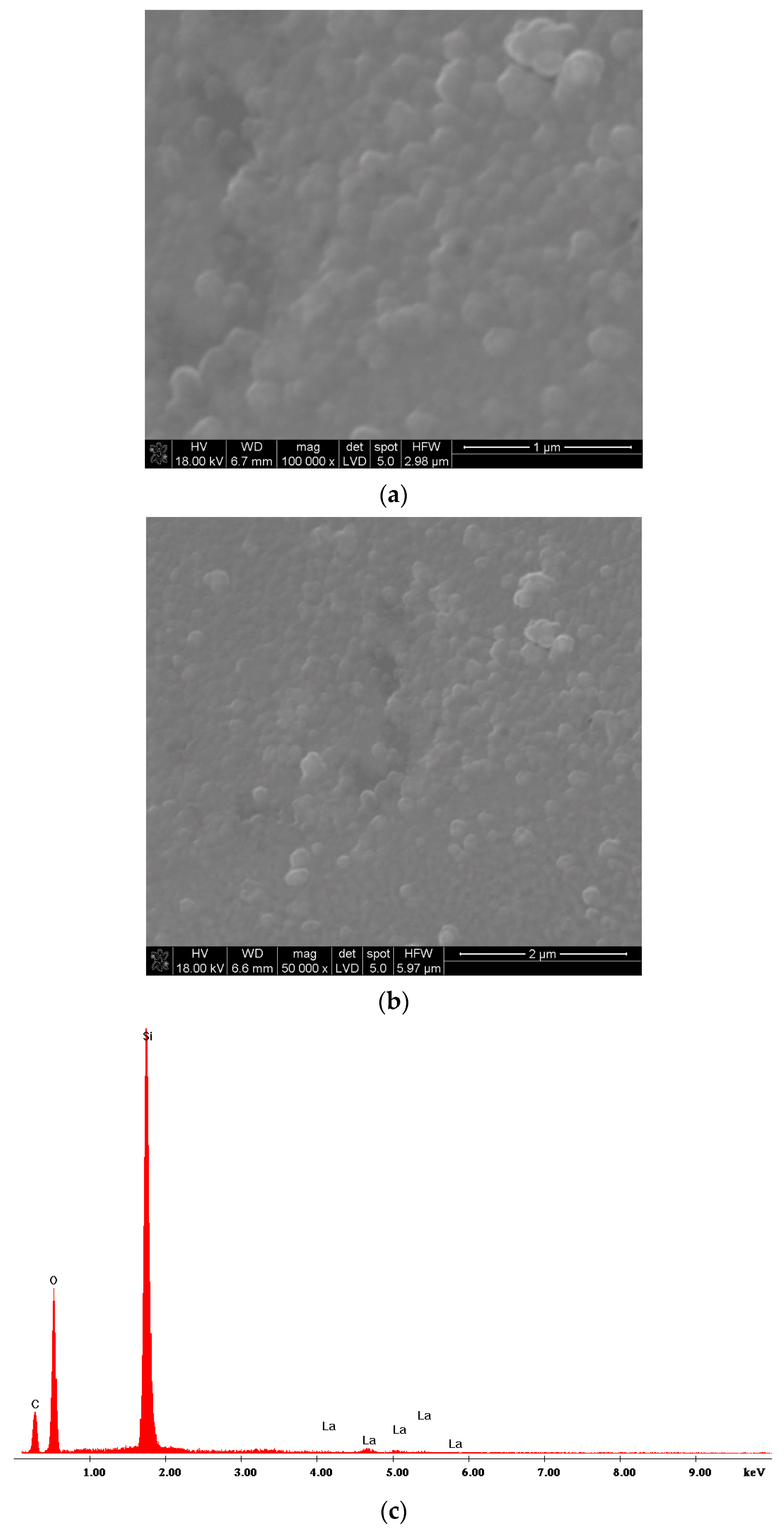
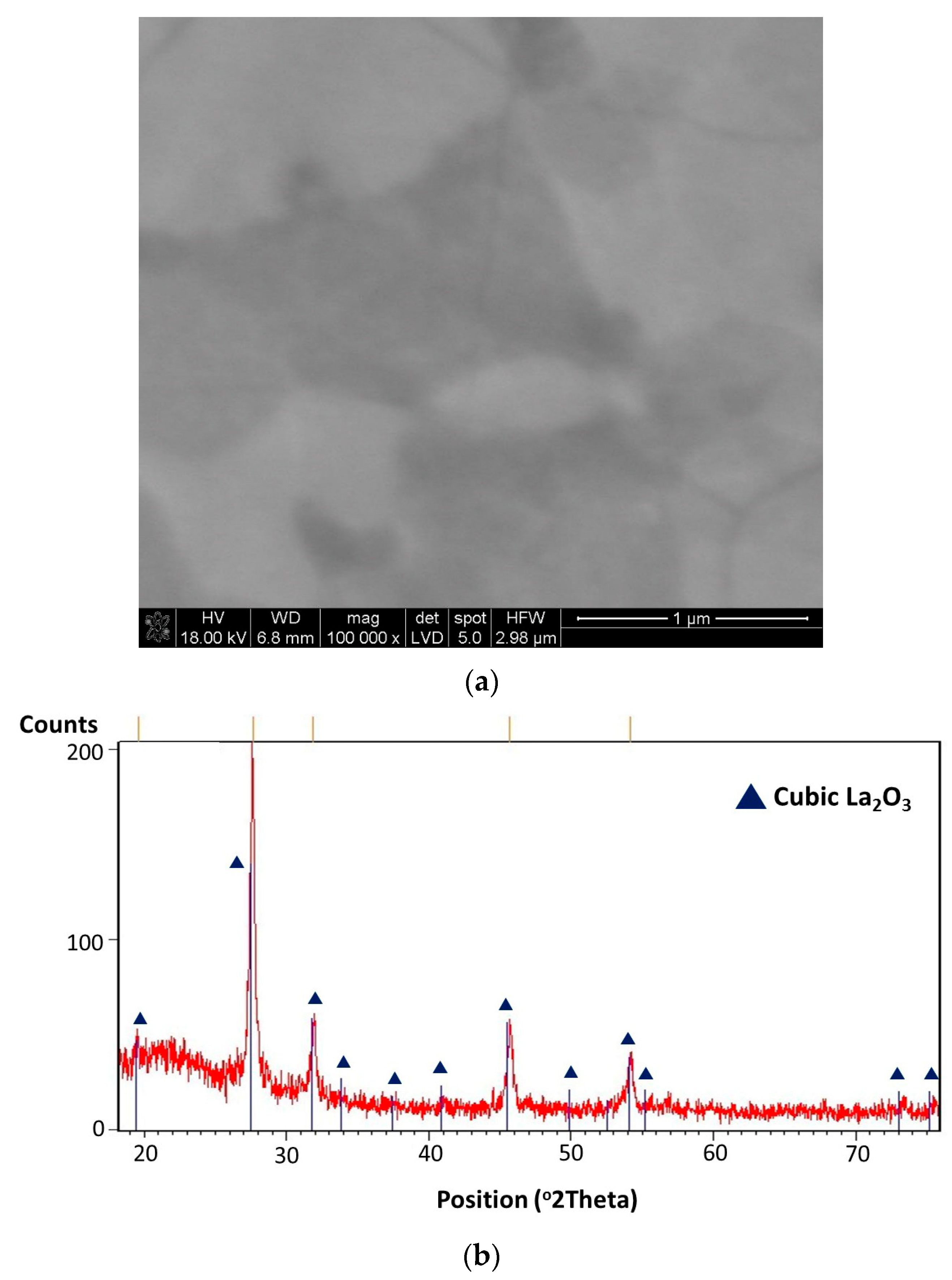
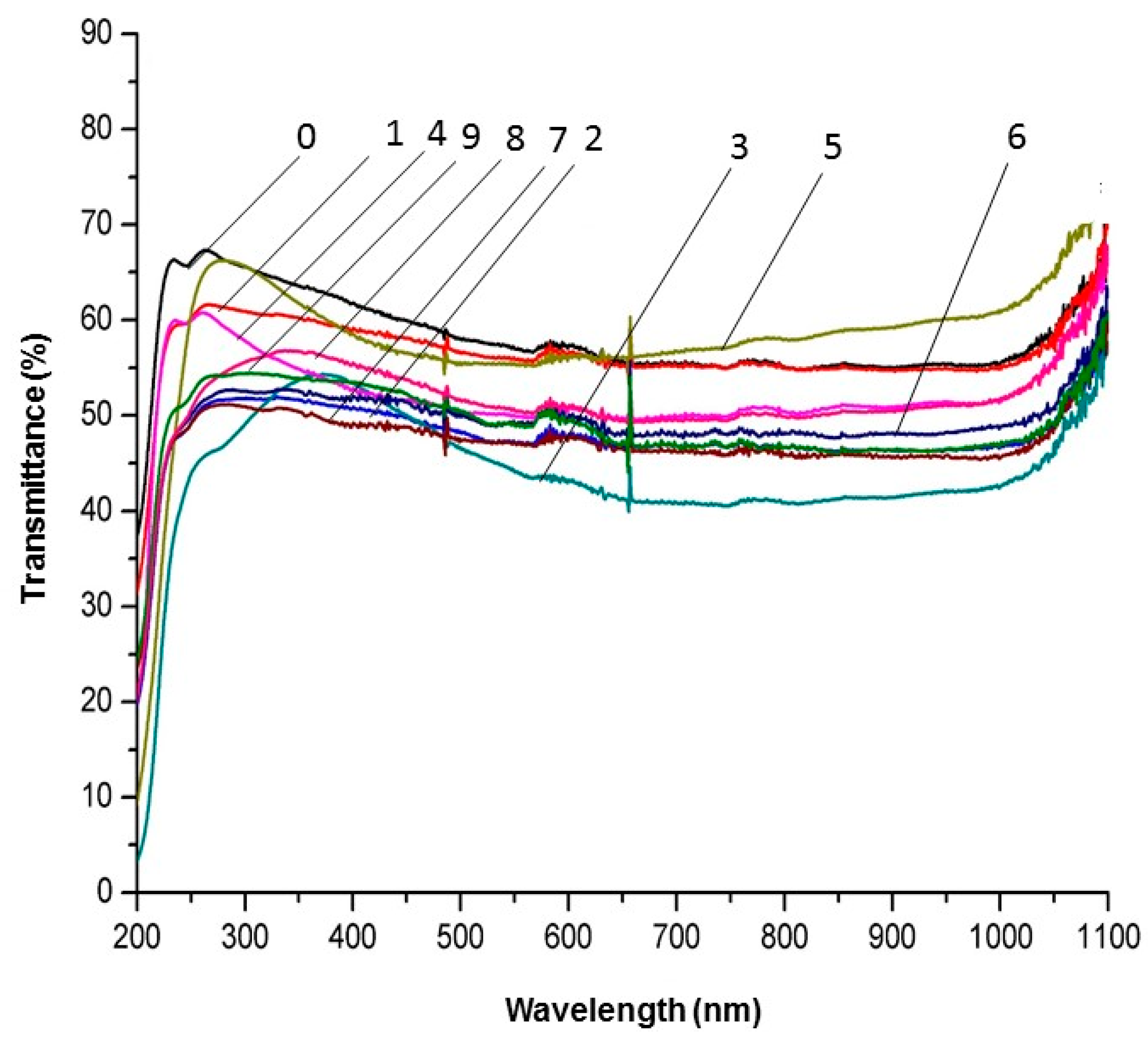
Disclaimer/Publisher’s Note: The statements, opinions and data contained in all publications are solely those of the individual author(s) and contributor(s) and not of MDPI and/or the editor(s). MDPI and/or the editor(s) disclaim responsibility for any injury to people or property resulting from any ideas, methods, instructions or products referred to in the content. |
© 2024 by the author. Licensee MDPI, Basel, Switzerland. This article is an open access article distributed under the terms and conditions of the Creative Commons Attribution (CC BY) license (https://creativecommons.org/licenses/by/4.0/).
Share and Cite
Sawka, A. Nanocrystalline Lanthanum Oxide Layers on Tubes Synthesized Using the Metalorganic Chemical Vapor Deposition Technique. Materials 2024, 17, 5539. https://doi.org/10.3390/ma17225539
Sawka A. Nanocrystalline Lanthanum Oxide Layers on Tubes Synthesized Using the Metalorganic Chemical Vapor Deposition Technique. Materials. 2024; 17(22):5539. https://doi.org/10.3390/ma17225539
Chicago/Turabian StyleSawka, Agata. 2024. "Nanocrystalline Lanthanum Oxide Layers on Tubes Synthesized Using the Metalorganic Chemical Vapor Deposition Technique" Materials 17, no. 22: 5539. https://doi.org/10.3390/ma17225539
APA StyleSawka, A. (2024). Nanocrystalline Lanthanum Oxide Layers on Tubes Synthesized Using the Metalorganic Chemical Vapor Deposition Technique. Materials, 17(22), 5539. https://doi.org/10.3390/ma17225539





